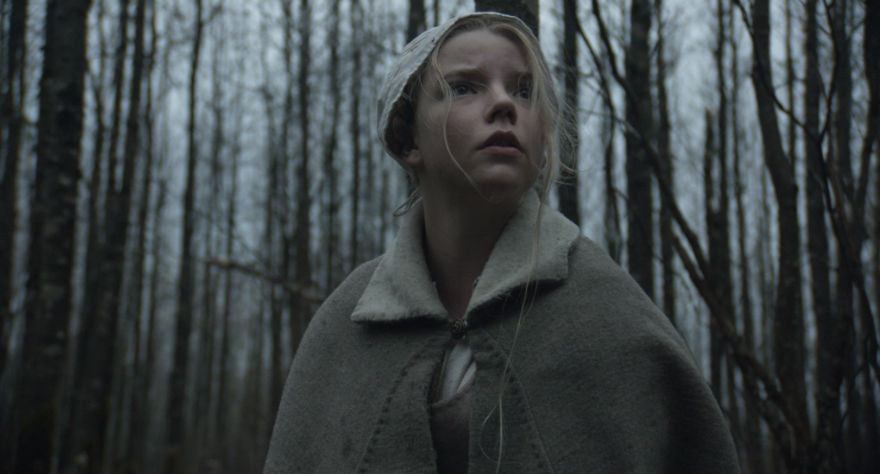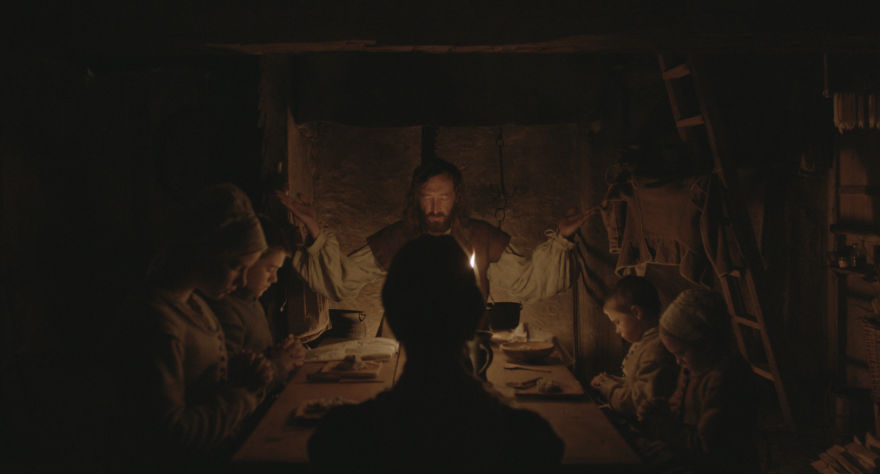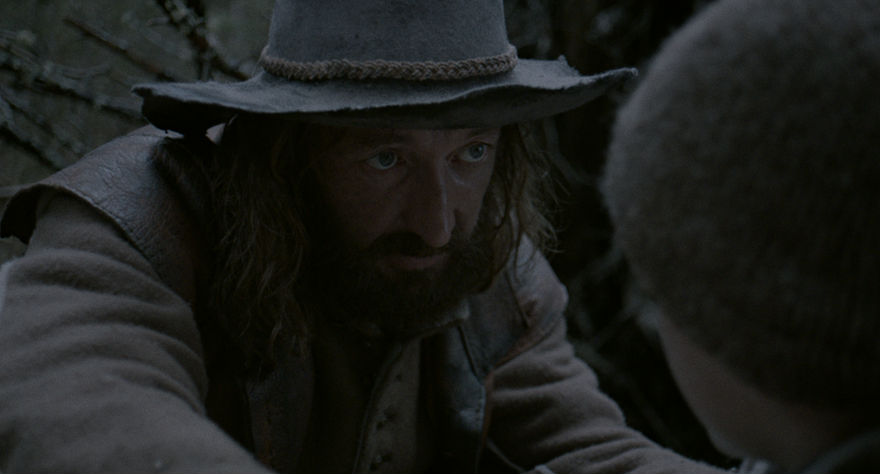Robert Eggers on ‘The Witch,’ What Makes the 17th Century Scary

Robert Eggers‘ The Witch opens this weekend, and if you shell out your hard-earned money to watch an independent, historically authentic period piece about a 17th-century Puritan family, I’d say that’s a win for all of us who love weird, geeky productions like this one. The slow-build horror movie centers on a cast-out family of seven living on the edge of a dark and scary wood, their minds warped and ires aimed at each other by an external, possibly supernatural force. Starring Ralph Ineson as the father, Kate Dickie as the mother and Anya Taylor-Joy in a breakout performance as their eldest daughter, the film is more Satanic-family-drama than scare-factory, though its climax had me absolutely frozen in fear. Atmospheric, well-acted and directed, and full of disturbing imagery you won’t be able to shake, The Witch is one horror fans shouldn’t miss.
In a roundtable interview, I spoke to Eggers about the film, which opens wide tomorrow, February 19th.

The 17th-century Puritanical mindset is something that’s pretty integral to your story. What’s special about it to you?
The most interesting thing to me was that the real world and the fairy-tale world were the same thing for everyone except for the extreme intelligentsia. Everyday life was imbued with supernatural stuff. Witches were real; that was something everyone knew and understood, and that was the end of the story. A witch today is a plastic Halloween decoration without a lot of impact, so if I could find a way to get audiences into the mindset of a 17th century English settler, the witch could be real and scary again.
Were there any models you had in terms of trying to recreate the sort of dead vernacular in the film?
I have a background in Shakespeare so I’m sort of comfortable around this kind of language but writing in it wasn’t easy. I studied the grammar and the vocabulary—there are books that do that kind of stuff—but then it was really digging into primary source material and jotting down phrases and sentences of all different kinds of situations and categorizing them. If I needed a greeting, I would take it. In earlier versions of the script, there were disastrous, cannibalized collages of other people’s words. It took a while to turn it into me. It’s a really interesting period for the English language.
What I really liked about the movie is it puts you in this state of mind that’s almost hallucinatory. I’d swear I saw things I didn’t actually see.
I like strong imagery and there were certain things I wanted to show. But your imagination is better than what I can give you. What scares you is more personal than anything I can provide. It’s important to keep things in the shadows and keep things restrained because then they can actually be effective. Some things, if I showed them to you, would not be scary—they’d just suck. Better to keep it in your imagination.
Was there anything you read in your research process that you really liked?
I don’t know if this is my favorite but I used it a hell of a lot: Louis Bayley’s The Practice of Piety, which was, like, a prayer manual. The majority of the prayers in the film are from that book. Kate Dickie, who played Katherine…the script would sometimes say “Katherine prays.” She had a digital version of that book on her iPad and she was just walking around the corn fields reading it. It was pretty cool.
Ralph Ineson has one of my favorite voices. Was his voice one of the reasons you wanted to cast him as William?
Honestly, before I thought we could cast Ralph, his voice was the voice of William when I wrote. I was expecting we were going to have to go down the route of getting a name to do our poor little indie movie. But luckily, when we finally found investors, they trusted in my vision to cast who I wanted. I was like, “Wow. Well…let’s try Ralph out!” He’s fucking incredible and he was so committed to the role. I’m happy to see him on the screen.
Did you set the movie in the early 17th century partly because there’s something inherently scary about that historical period?
Yeah. The idea of the supernatural world being real in the past was kind of crucial for me. When we do supernatural movies that take place today I find it hard. It’s metaphysical truths that don’t work for anyone today. There are obviously successful examples that prove me wrong, for sure, but I also just like the past. I don’t want to make contemporary movies currently. I just don’t give a shit. People ask why it’s set in 1630 and not during the Salem witch trials. Aside from the fact that I could have never afforded to have something of that scope, this is much scarier. [The family’s] so much more vulnerable because they’ve just arrived at this place.

Female repression is something that exists today but in the time your movie’s set, it was much more extreme. I imagine it’s helpful to your story that women in this period kind of had this ceiling they’re never able to break through. That’s a big theme.
I tried my damnedest to do my interpretation of how a family in Puritan New England might have experienced a witching. I wanted the camerawork to be subjective but I wanted to be objective about the themes and let people come to their own conclusions. Feminism just bursts onto the screen, out of history. It just rises to the top. You cannot ignore it. It’s clear, looking back from a contemporary perspective, that the evil witch in the early modern period is men’s fears and ambivalences and desires and fantasies about women and female power. It’s also women’s own fears about themselves and their own power and fears about motherhood. The shadows of that still exist today. Sometimes they ain’t shadows.
There’s sort of a hint in the movie involving moldy corn [as to what’s going on with this family]. How important was it to give moderns an idea of what was happening?
That’s cool that you saw the ergot because most people don’t. I one billion percent do not think Salem was because of ergot of the rye. I sound like a freshmen in college, constructionist loser, but we live in a world with certain rules that are given to us by science and we say it’s the best way of understanding things. But science really isn’t objective, actually. Today, science is our god. It’s not too juvenile to say that, in one hundred years, people will look back at us and think we’re wacky. All these different pieces, from ergot to what’s in your imagination, is all tied up in interesting knots.
Costume design is something I’ve been fascinated with lately. What was your approach?
We were just trying to recreate the clothing of the time. I took a lot of work. The source material, the creation of the script, is pretty easy to access for anyone. But the stuff we had to do to make the clothing and build the farm was more obscure. I was working with historians and museums and people in the living history communities to try to create this stuff. I did so much research for years, waiting to get the money. When I brought on Craig Lathrop and Linda Muir, I gave them piles of stuff and they were pumped. We went to great lengths. All the clothes were hand-stitched and made from patterns of extant clothing. One big compromise is that they are not all hand-woven cloth. Linda ordered swatches of all this stuff, and when we could afford it we used it, but where we couldn’t, her modern equivalents were fantastic.
With the farm, I wanted to build it the way they did back then, end of story. Craig said, “That sounds like a great idea but it’s the winter and we’re never going to be able to do it when we’re up to our balls in snow.” But everything that’s onscreen is the real thing. Everything onscreen is going to be the real materials. That did mean having to use traditional techniques and tools to make the stuff. Where we could use modern tools we did, but if modern tools betrayed the authenticity to the camera, we couldn’t use them.
